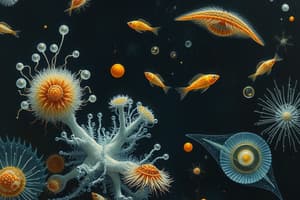Podcast
Questions and Answers
What is the primary food source for other marine life?
What is the primary food source for other marine life?
- Nektonic organisms
- Benthic organisms
- Pelagic organisms (correct)
- Deep-sea organisms
What do flying squids use for propulsion?
What do flying squids use for propulsion?
- Forcing water out of their cavities
- Muscular contractions
- Trapping water in their mantle cavity (correct)
- Using a sail-like structure
What do many marine animals use to help with buoyancy and avoid sinking?
What do many marine animals use to help with buoyancy and avoid sinking?
- Gas containers or swim bladders (correct)
- Anchoring themselves to the ocean floor
- Heavy exoskeletons
- Increased body weight
What do medusas, like Portuguese man-of-war, use for directional movement?
What do medusas, like Portuguese man-of-war, use for directional movement?
What do copepods, microscopic shrimp, make up the majority of in the ocean?
What do copepods, microscopic shrimp, make up the majority of in the ocean?
What do predatory fish have different muscle tissue colors for?
What do predatory fish have different muscle tissue colors for?
What do radialarian and foraminifera zooplankton have tests made of?
What do radialarian and foraminifera zooplankton have tests made of?
What do deepwater nekton use to attract prey and mates?
What do deepwater nekton use to attract prey and mates?
What role do krill play in the food web?
What role do krill play in the food web?
What is an adaptation used by smaller fish to confuse predators and appear larger in numbers?
What is an adaptation used by smaller fish to confuse predators and appear larger in numbers?
Where do pelagic organisms live?
Where do pelagic organisms live?
What is swimming speed generally proportional to in fish?
What is swimming speed generally proportional to in fish?
What do nektonic organisms have evolved streamlined shapes and fins to do?
What do nektonic organisms have evolved streamlined shapes and fins to do?
What do fish use different fin designs for?
What do fish use different fin designs for?
What are examples of animals with gas containers for buoyancy?
What are examples of animals with gas containers for buoyancy?
What type of swimming motion is used by various organisms?
What type of swimming motion is used by various organisms?
What distinguishes zooplankton from nektonic organisms?
What distinguishes zooplankton from nektonic organisms?
What have deepwater nekton adapted to perpetual darkness with?
What have deepwater nekton adapted to perpetual darkness with?
What are examples of cnidarians?
What are examples of cnidarians?
What do cold-blooded fish typically not excel in compared to warm-blooded fish?
What do cold-blooded fish typically not excel in compared to warm-blooded fish?
Flashcards are hidden until you start studying
Study Notes
Adaptations for Swimming in Marine Organisms
- Swimming mechanisms of marine organisms include muscular contractions, water entering and forced out of their cavities
- Medusas, like Portuguese man-of-war, use a sail-like structure for directional movement
- Different swimming organisms include fish, squid, sea turtles, and marine mammals
- Flying squids trap water in their mantle cavity for propulsion
- Fish use different fin designs for stabilization, steering, balance, and thrust
- Different swimming motions include S-shaped and L-shaped, used by various organisms
- Predatory fish have different muscle tissue colors for different swimming strategies
- Swimming speed is generally proportional to the size of the fish
- Cold-blooded fish are typically not fast swimmers, while warm-blooded fish are more efficient
- Deepwater nekton have adapted to perpetual darkness by using bioluminescence to attract prey and mates
- Deepwater nekton have large, sensitive eyes, sharp teeth, expandable jaws, and a large belly for scarce food
- Schooling is an adaptation used by smaller fish to confuse predators and appear larger in numbers
Studying That Suits You
Use AI to generate personalized quizzes and flashcards to suit your learning preferences.




